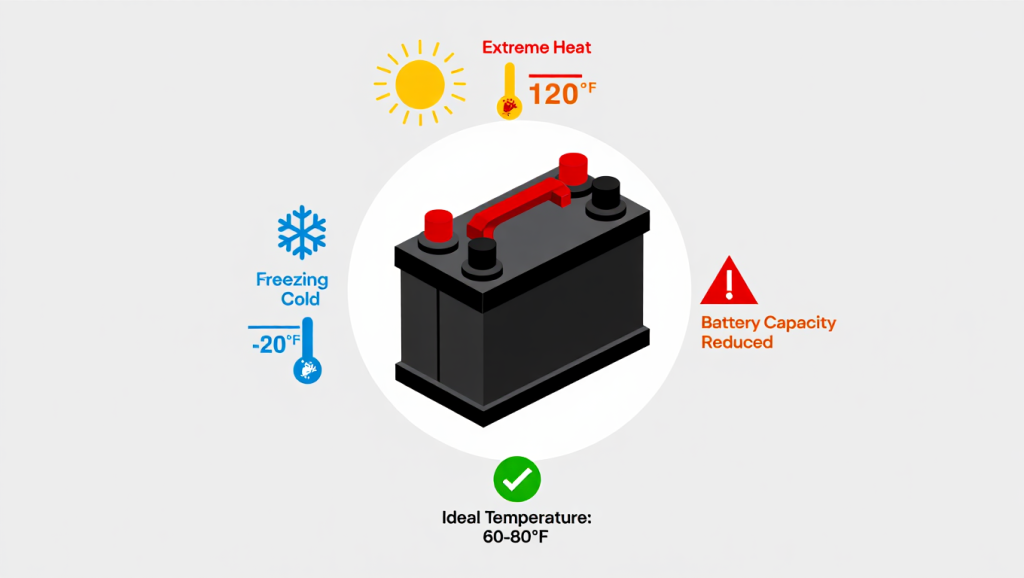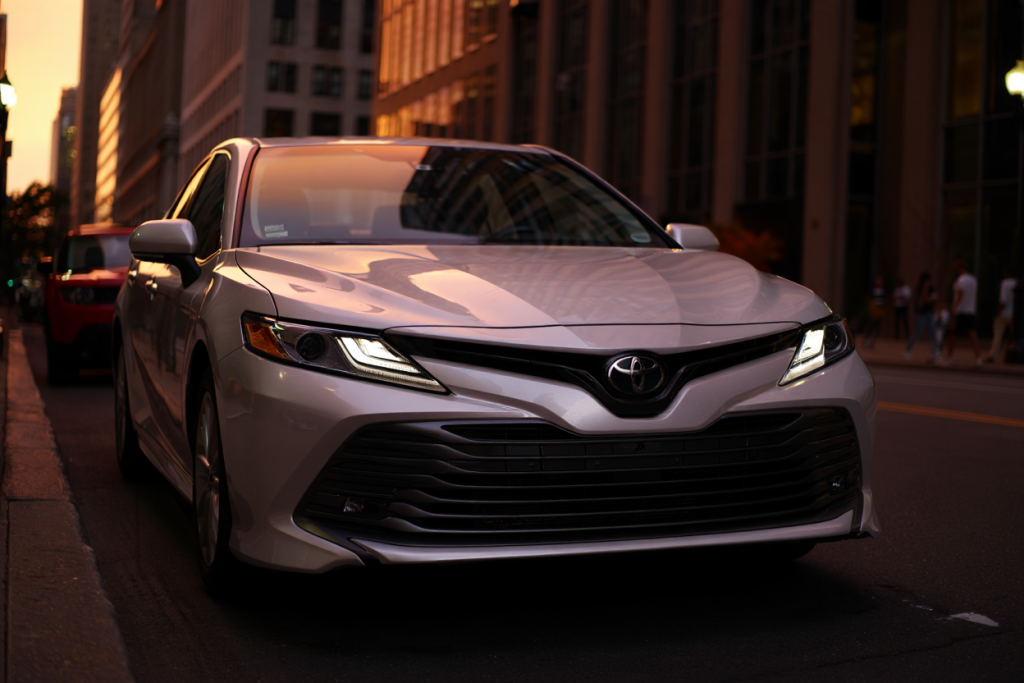Most drivers blame a dead battery on bad luck, but the truth is, weather conditions play one of the biggest roles in how long your car battery lasts. Both extreme heat and freezing cold put extra stress on a battery, leading to poor performance, higher replacement costs, and unexpected breakdowns.
In this guide, I’ll break down the science of batteries, how weather affects them, symptoms of failure, common mistakes drivers make, and practical tips to keep your car battery alive longer. Whether you drive a compact commuter, a pickup, or a luxury vehicle, understanding these factors can save you money and headaches.
The Science Behind Car Batteries and Weather
Before we dive into hot summers and freezing winters, it’s important to understand how a car battery works and why it’s so sensitive to temperature changes.
How a Car Battery Works
At its core, a car battery is a box of chemistry. Inside are lead plates submerged in an electrolyte solution (sulfuric acid mixed with water). When you turn the key or press the start button, a chemical reaction creates electricity to power the starter motor and other electronics.
Several performance measurements matter when buying a battery:
- Cold Cranking Amps (CCA): The measure of how well the battery can deliver power in freezing weather.
- Reserve Capacity (RC): How long the battery can power essential systems if the alternator stops working.
- Voltage: Healthy car batteries usually read 12.6 volts when fully charged.
Because these chemical reactions depend on temperature, batteries behave very differently in summer heat versus winter cold.
Temperature Sensitivity of Electrolyte Solutions
The electrolyte solution inside your battery is like the lifeblood of the system. In hot weather, chemical activity speeds up, which can damage the plates and evaporate fluid. In cold weather, reactions slow down, cutting available power in half.
The “sweet spot” for battery performance is around 77°F (25°C). Deviate too far above or below, and you’ll see reduced performance and shorter life. This is why drivers in Arizona or Minnesota often replace their batteries more often than those in mild climates like California.
Effects of Hot Weather on Car Batteries
Hot weather may feel great on a beach trip, but it’s brutal on car batteries. Let’s look at how high temperatures affect performance and lifespan.
Heat-Related Battery Failures
Excessive heat evaporates the electrolyte inside the battery. When levels drop, the lead plates are exposed, causing internal damage and reducing capacity. Heat also accelerates corrosion on terminals and connectors. In severe cases, the battery case can swell or warp—a clear sign it’s been cooked.
OEM batteries in hot climates often fail after just 2–3 years. Aftermarket AGM (Absorbent Glass Mat) batteries are more resistant, but even they take a beating in places like Phoenix, where pavement temps exceed 140°F.
Symptoms of Heat-Damaged Batteries
You’ll often notice signs before the battery dies completely:
- A bulging or warped battery case.
- A strong rotten egg smell, caused by leaking sulfuric acid.
- The battery holds a charge for only a few hours, even after driving.
Cost & Replacement Considerations
Replacing a heat-damaged battery typically costs $100–$300, depending on whether you choose a lead-acid or AGM battery. While AGM costs more upfront, it’s the best battery type for hot climates because it’s sealed, spill-proof, and more resistant to evaporation. Over 5–7 years, it often proves more cost-effective than replacing a cheaper battery every 2–3 years.
Effects of Cold Weather on Car Batteries
Winter is when most drivers notice battery problems. A battery that survived summer heat often fails once temperatures drop.
Why Cold Makes Starting Harder
Cold weather slows down the chemical reactions inside your car battery, cutting available power by as much as 50% at 0°F (-18°C). At the same time, your engine oil thickens, making it harder to crank the motor. Combine these two, and your car struggles to start.
This is why CCA (Cold Cranking Amps) is so important. A battery with a low CCA rating may start fine in summer but leave you stranded on a January morning.
Symptoms of Cold-Weather Battery Trouble
Signs of a battery struggling in cold weather include:
- Slow cranking or a repeated clicking sound when you try to start.
- Dim headlights when you turn the key.
- The car only starts after multiple attempts.
These are red flags that your battery is near the end of its life. Many shops offer free winter battery checks, which can save you from being stranded in the snow.
Cost & Lifespan in Cold Climates
Batteries in cold regions typically last 3–4 years, compared to 5+ years in mild climates. Choosing a battery with a higher CCA rating is crucial for winter reliability.
For example:
- Budget lead-acid battery: $70–$150, lifespan 3–4 years.
- Premium AGM battery: $180–$300, lifespan 4–6 years.
While OEM batteries may be sufficient, upgrading to an aftermarket AGM battery in cold regions is a smart investment for peace of mind.
Seasonal Transitions and Battery Stress
Many drivers assume batteries only fail in extreme hot or cold, but fall and spring can be just as tough. That’s because rapid temperature swings cause expansion and contraction inside the battery, weakening already stressed cells.
A common scenario: your battery survives summer, but when the first real cold snap hits in November, it dies. That’s not a coincidence—the damage was already done, and the cold simply exposed the weakness.
To avoid this, mechanics recommend pre-winter battery testing. A quick load test can reveal if your battery is strong enough to handle freezing mornings or if it’s time to replace it before winter begins.
Common Mistakes Drivers Make with Weather and Batteries
Even the best battery won’t survive long if it’s neglected. Here are the top mistakes I see drivers make:
- Buying the cheapest battery available. Short-term savings usually mean earlier replacements.
- Ignoring OEM recommendations. If your vehicle was designed for AGM, downgrading to lead-acid can cause electrical issues.
- Skipping seasonal checks. Batteries should be inspected before winter and summer.
- Using tap water instead of distilled water in serviceable batteries—minerals cause corrosion.
- Letting cars sit unused for weeks in extreme weather, which drains and sulfates the battery.
- Assuming new batteries are weather-proof. Even fresh batteries degrade if exposed to harsh heat or cold without maintenance.
Practical Tips to Protect Your Car Battery from Weather Damage
Weatherproofing your battery isn’t impossible—it just takes a few preventive steps.
Summer Battery Care Tips
Heat damage is preventable if you:
- Park in shade or covered areas whenever possible.
- Check electrolyte levels if your battery is serviceable.
- Keep terminals clean and coated with anti-corrosion spray.
A simple habit like popping the hood to release heat after a long drive can reduce under-hood temperatures and extend battery life.
Winter Battery Care Tips
In freezing regions, extra care goes a long way:
- Install a battery heater or blanket to keep temperatures stable.
- Use a smart charger or maintainer if you don’t drive daily.
- Always check the CCA rating before buying a new battery.
Truck owners in the Midwest often keep their vehicles plugged in overnight with engine and battery warmers—it’s cheap insurance against no-start mornings.
Year-Round Maintenance Tips
No matter where you live:
- Test battery voltage twice a year—before summer and winter.
- Ensure connections are tight and corrosion-free.
- Stick with OEM-recommended battery types or trusted aftermarket brands.
Following these tips can add 1–2 years to your battery’s lifespan, saving $100–$200 over time.
Cost Breakdown: Battery Replacement by Climate
The average lifespan and cost of replacement depends heavily on your environment:
| Climate | Avg. Lifespan | Recommended Battery | Replacement Cost |
| Hot (Texas, Arizona) | 3 years | AGM | $180–$300 |
| Mild (California, Oregon) | 4–5 years | Lead-acid or AGM | $70–$300 |
| Cold (Minnesota, Canada) | 3–4 years | AGM w/ high CCA | $150–$300 |
While AGM is more expensive upfront, it often works out cheaper long-term in extreme climates due to fewer replacements and better reliability.
Conclusion
Your car battery’s lifespan isn’t just about brand or type—it’s heavily influenced by weather. Heat shortens life, cold reduces power, and seasonal swings expose weakness. The good news is that with the right battery choice, preventive care, and seasonal checks, you can avoid most failures.
Don’t wait until your car won’t start in the driveway. Test your battery before extreme weather hits, and when it’s time for a replacement, choose a battery that matches your climate and driving needs.
FAQs
- Why does my battery die more often in winter than summer?
Cold weather slows down chemical reactions in the battery, reducing cranking power by up to 50%. Combined with thick engine oil, it makes starting harder. If your battery is already weak, the cold often finishes it off, which is why failures are common in winter. - Is hot or cold weather worse for a car battery?
Both extremes are tough. Heat shortens battery life by evaporating electrolyte and corroding plates, while cold reduces starting power. Heat kills batteries slowly, cold exposes the weakness suddenly. In short, hot weather shortens lifespan, but cold weather reveals the failure. - Should I buy a different battery type depending on my climate?
Yes. In hot climates, sealed AGM batteries resist evaporation better. In cold regions, batteries with high Cold Cranking Amps (CCA) are essential for reliable starts. Mild climates allow more flexibility, but AGM still provides longer life and better durability than standard lead-acid. - How can I tell if my battery is heat-damaged?
Signs include a bulging battery case, leaking fluid, and a rotten egg smell from sulfuric acid. The battery may also fail to hold a charge even after driving. Heat-damaged batteries are unsafe and should be replaced immediately to avoid breakdowns or electrical issues. - Do AGM batteries last longer in extreme weather?
Yes. AGM batteries handle both heat and cold better than standard lead-acid. They resist evaporation, recharge faster, and deliver stronger cranking power in freezing conditions. While they cost more upfront, their durability makes them the best battery choice for extreme climates. - How often should I test my battery in harsh climates?
At least twice a year—once before summer and once before winter. In regions with severe heat or cold, quarterly testing is even better. Many auto parts stores and mechanics offer free load testing, which can reveal problems before the battery leaves you stranded.

Benjamin Grey is an automotive engineer and writer at Car Parts Advisor. With years of experience in the automotive industry, he shares expert advice on car parts, maintenance, and repairs to help car owners keep their vehicles running smoothly.





